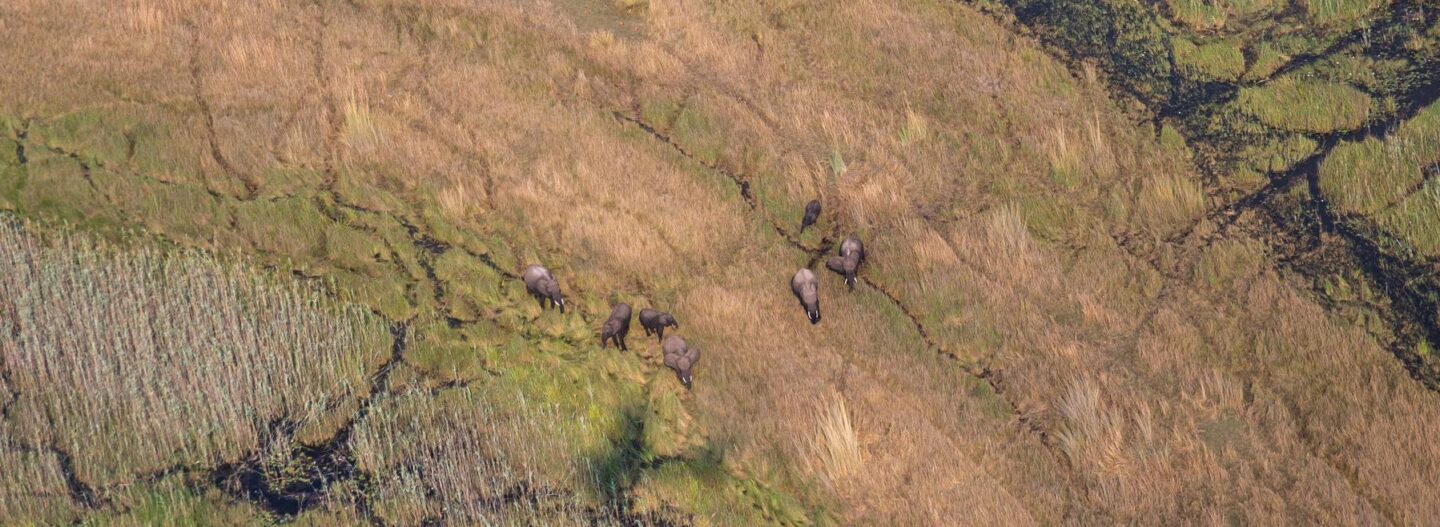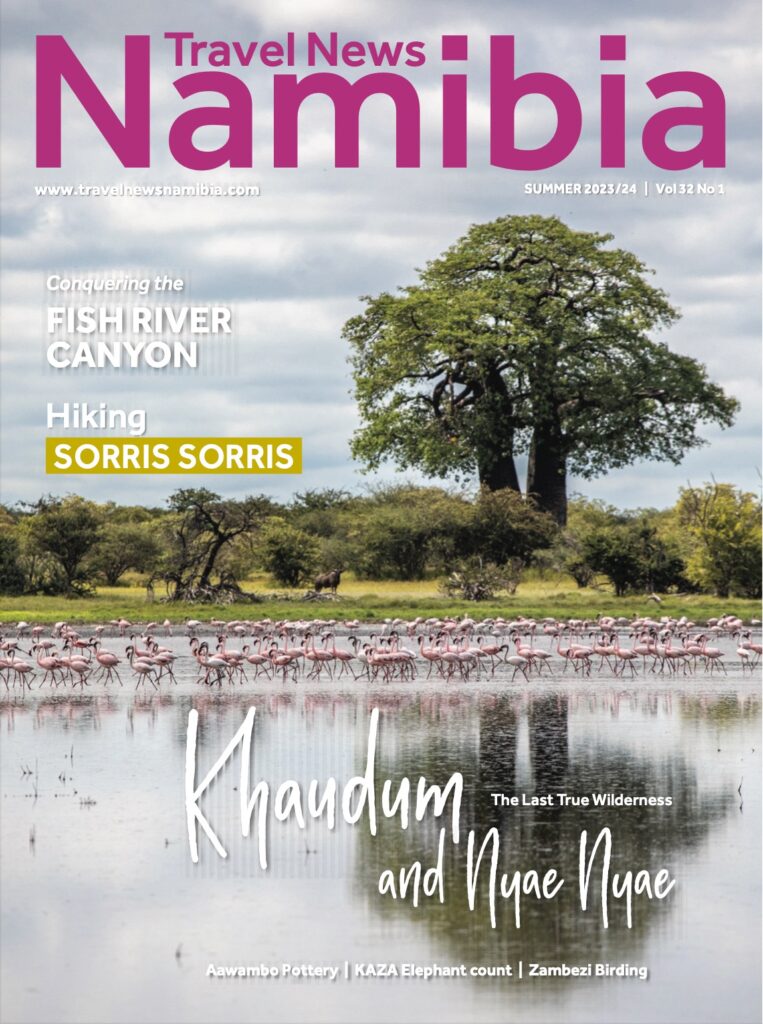
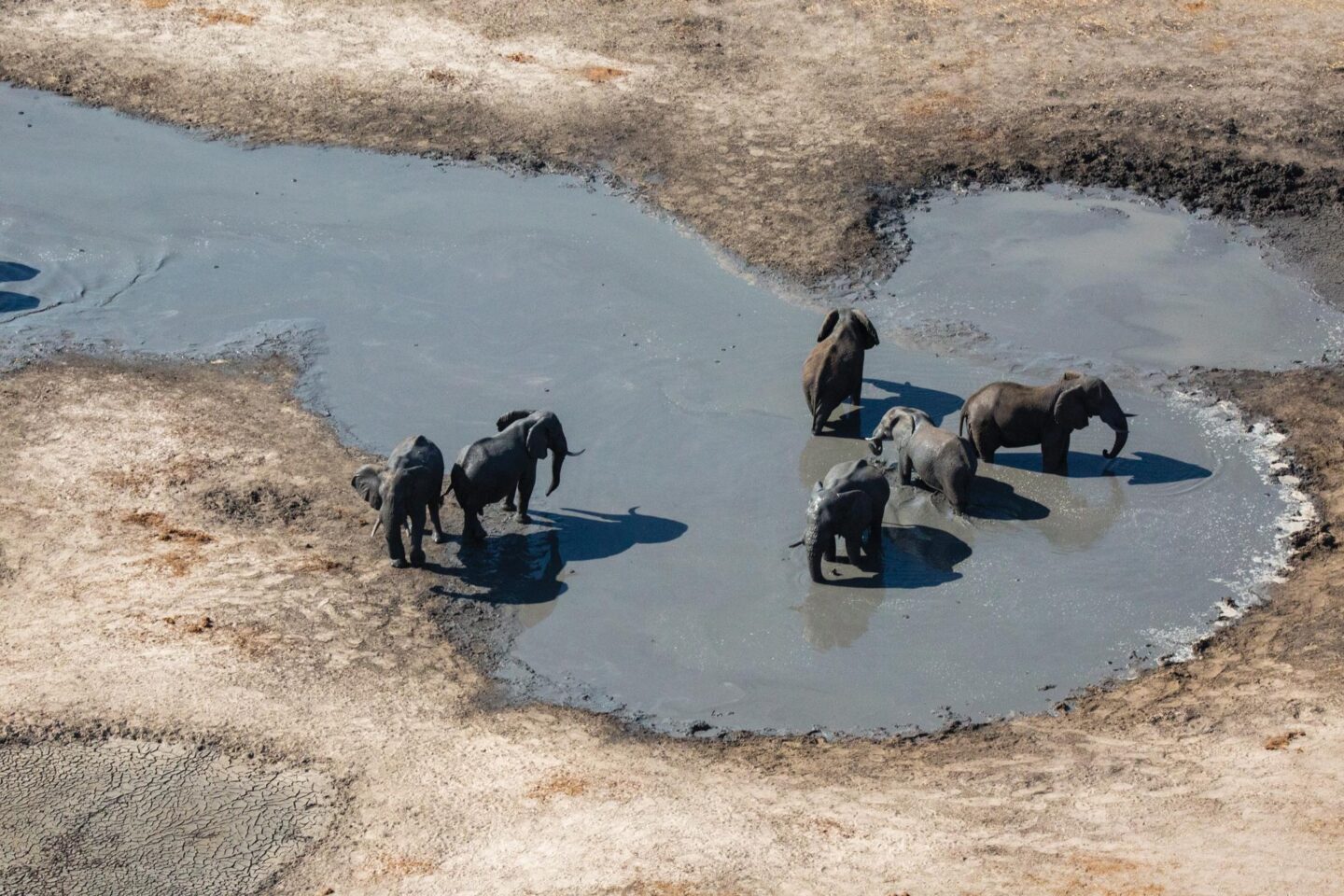
The Kavango-Zambezi transfrontier
ELEPHANT SURVEY
The first flight to begin an elephant survey covering parts of Angola, Botswana, Namibia, Zambia and Zimbabwe took off from a dirt strip in Zimbabwe on 22 August 2022. The survey area, known as the Kavango-Zambezi Transfrontier Conservation Area (KAZA TFCA), hosts over half of Africa’s savanna elephants, which underlines the importance of the survey.
Text & Photographs Ministry of Environment, Forestry and Tourism and WWF Namibia
From the Summer 2023/24 issue
A lmost a year later, after careful analysis and peer overview, the results of the survey were shared by the KAZA member states. The elephant population for the region was estimated to be a staggering 227,900 and confirmed numbers from previous counts held in each of the five countries. The survey also showed that populations were growing in some countries and declining in others, but remained stable over the whole region.
Previously, regional elephant surveys have aggregated results from separate surveys. The KAZA survey was the first to use a coordinated and synchronised flight plan that follows aerial survey standards developed by MIKE (Monitoring the Illegal Killing of Elephants) under CITES (the Convention on International Trade in Endangered Species of Wild Fauna and Flora).
Coordinating the elephant survey across borders was challenging, but worth it: “The KAZA-wide elephant survey brought the five partner countries together. It demonstrated the need for us to work together and to learn together. It reinforced the rationale of why we value the Kavango-Zambezi TFCA,” Kenneth /Uiseb, Deputy Director of the Ministry of Environment Forestry and Tourism said.
The survey was conducted from August to October 2022 during the dry season when most trees are bare, thus maximising visibility. It covered 60% of the KAZA TFCA’s 520,000 km² and focused on areas in the landscape where elephants are known to occur. Pilots and observers flew 67,000 kilometres of transects, nearly twice the circumference of our globe.
Dr Russell Taylor, the transboundary conservation planning advisor from WWF Namibia, who has been flying in this region for decades, commented on the importance of synchronised flights for establishing strong baselines and increasing our understanding of elephant cross-border movements and dynamics. He had already stressed this need at a meeting of the KAZA Conservation Working Group held in Calais, Angola, in 2011: “We knew that an aerial survey would help to identify gaps in our knowledge of the area, and allow us to safely survey areas that had been land mined during Angola’s civil war. Twelve years later, for me this survey was an aspiration come true.”
/Uiseb added that without collaboration it would have been impossible to pull off such a complex survey. “Donors provided the funding, partner countries gave the necessary permissions and civil aviation authorities approved the aircraft used in the survey to fly in all the different countries. The people who participated were nominated by partner countries and needed training, so the survey team used this opportunity for capacity building,” he said.
ELEPHANT NUMBERS IN KAZA AND NAMIBIA
Botswana accounted for 58% of the elephant population, Zimbabwe for 29%, Namibia for 9%, and the remaining 4% of elephants were found in Zambia and Angola combined. The surveyors also found an estimated 26,641 (±1,645) elephant carcasses, or 10.47% of the live elephant population. This suggests a high level of mortality, which warrants further investigation as a potential warning sign for the health and stability of the elephant population.
Namibia’s Zambezi Region has been described as the sword that cuts through KAZA, or as the key that unlocks its full potential. This pivotal landscape links the KAZA countries and provides the corridors for wildlife to move from one country to another. Namibia’s total land contribution to the KAZA TFCA includes parts of Kavango East and the Zambezi Region (12,345 (±2,519) elephants), as well as Khaudum National Park and the Nyae Nyae Conservancy (8,745 (±3,009) elephants).
| COUNTRY | KAZA SURVEY | 2016 AESR |
| Angola | 5,983 | 3,395 |
| Botswana | 131,909 | 129,939 |
| Namibia | 21,090 | 19,549 |
| Zambia | 3,840 | 6,688 |
| Zimbabwe | 65,028 | 57,398 |
| Total | 227,900 (±16,743) |
The results of the coordinated KAZA elephant survey in 2022 compared with surveys held in 2014-15 for the same area, as shown in the IUCN (International Union for the Conservation of Nature) African Elephant Specialist Report (2016 AESR).
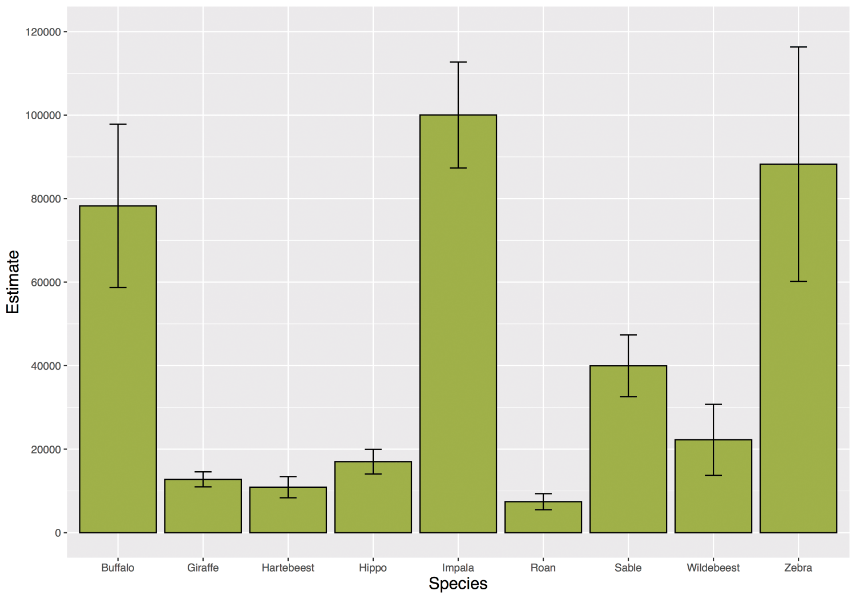
Estimates of the other large wild herbivores seen during the KAZA TFCA aerial survey.
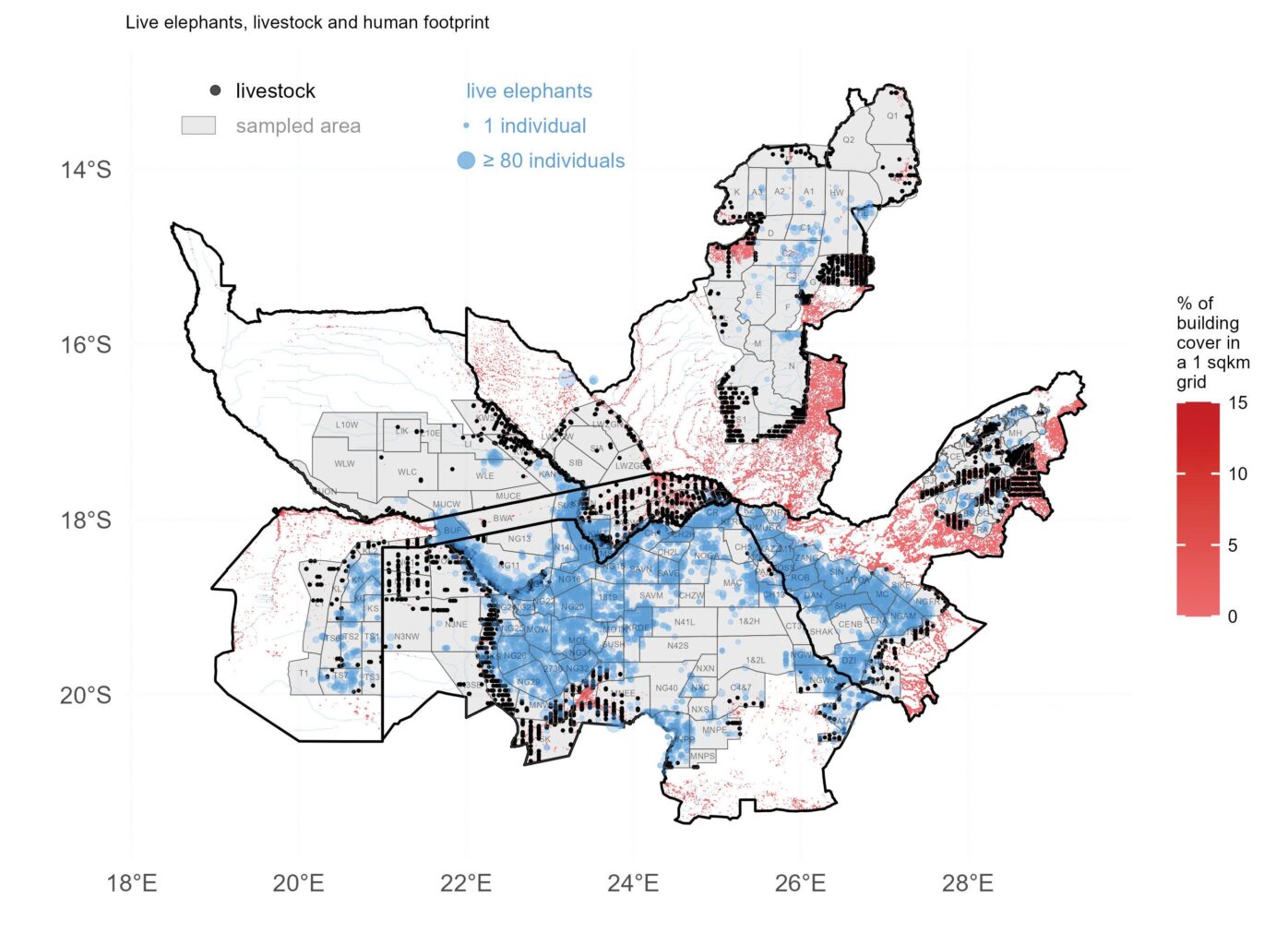
Spatial distribution of live elephants (bulls and family herds) and livestock observations in the KAZA TFCA survey area during the 2022 survey, overlaid on a human settlement density map created from the Open Buildings dataset (Sirko et al, 2021).
MAPPING HUMAN ACTIVITIES AND WILDLIFE
The KAZA survey team maximised the opportunity provided by the elephant survey to count as many other large animals as they could see, including livestock. “We have identified wildlife corridors based on their utilisation with data mainly from collared elephants’ movements. This survey provides us with another layer of information,” /Uiseb said. “It gives us a snapshot of how the elephants and other wildlife are distributed, a view of communities and their activities, and how settlements and livestock are distributed.” Decision makers can use this information for conservation planning and for working with the local communities to create space that can be used by wildlife without affecting livestock farming.
The size of the domestic livestock herd in the surveyed area was estimated at 736,426, of which 73% were cattle and 24% sheep and goats. When combining the number of elephants and all other large herbivores counted, the ratio is 1.16 wild herbivores per domestic animal. The survey also pinpointed human settlements and mapped the distribution of livestock and wildlife (see map).
MAKING THE COUNTS COUNT FOR CONSERVATION AND SUSTAINABLE DEVELOPMENT
All five partner states will use the results of the survey as a source of information when implementing the Strategic Planning Framework for the Conservation and Management of Elephants in the KAZA TFCA. This framework aims “to ensure the long-term survival of the species, with the vision that KAZA’s elephant population is conserved for the benefit of both people and nature within a diverse and productive landscape.”
Ongoing monitoring and research will play a vital role in assessing the conservation status of elephants in the KAZA TFCA. By continuously evaluating population trends, addressing key threats and promoting sustainable conservation practices, the partner countries and stakeholders can work towards ensuring the long-term survival of the species.
One result that warrants further investigation is the overall carcass ratio of 10.47%. “Several factors are likely contributing to the somewhat elevated mortality we’re observing,” KAZA Elephant Survey coordinator Darren Potgieter said. “Factors such as ageing populations, improved sampling methodologies, disease, environmental conditions and poaching could all be at play here.”
Looking forward, /Uiseb noted, “The landscape is changing. We are experiencing climate change, an increase in human population, an increase in livestock, an increase in elephants, and a lot of investment in conservation and community development. All this is taking place in a concentrated area, so you need to understand through repeated surveys the relationship between wildlife and livestock to see which of the two is increasing in number and what this increase means for the other.”
Surveys allow us to build information bases that can be used in future research and to make predictions, model populations, create early warning systems and predict the impact of climate change on this dynamic system. The KAZA partner countries are committed to keep monitoring and conserving the elephants and wildlife in this, the largest trans- frontier conservation area on earth. TNN
First published in the 2023 issue of the Conservation and the Environment in Namibia magazine.
Visit www.conservationnamibia.com

